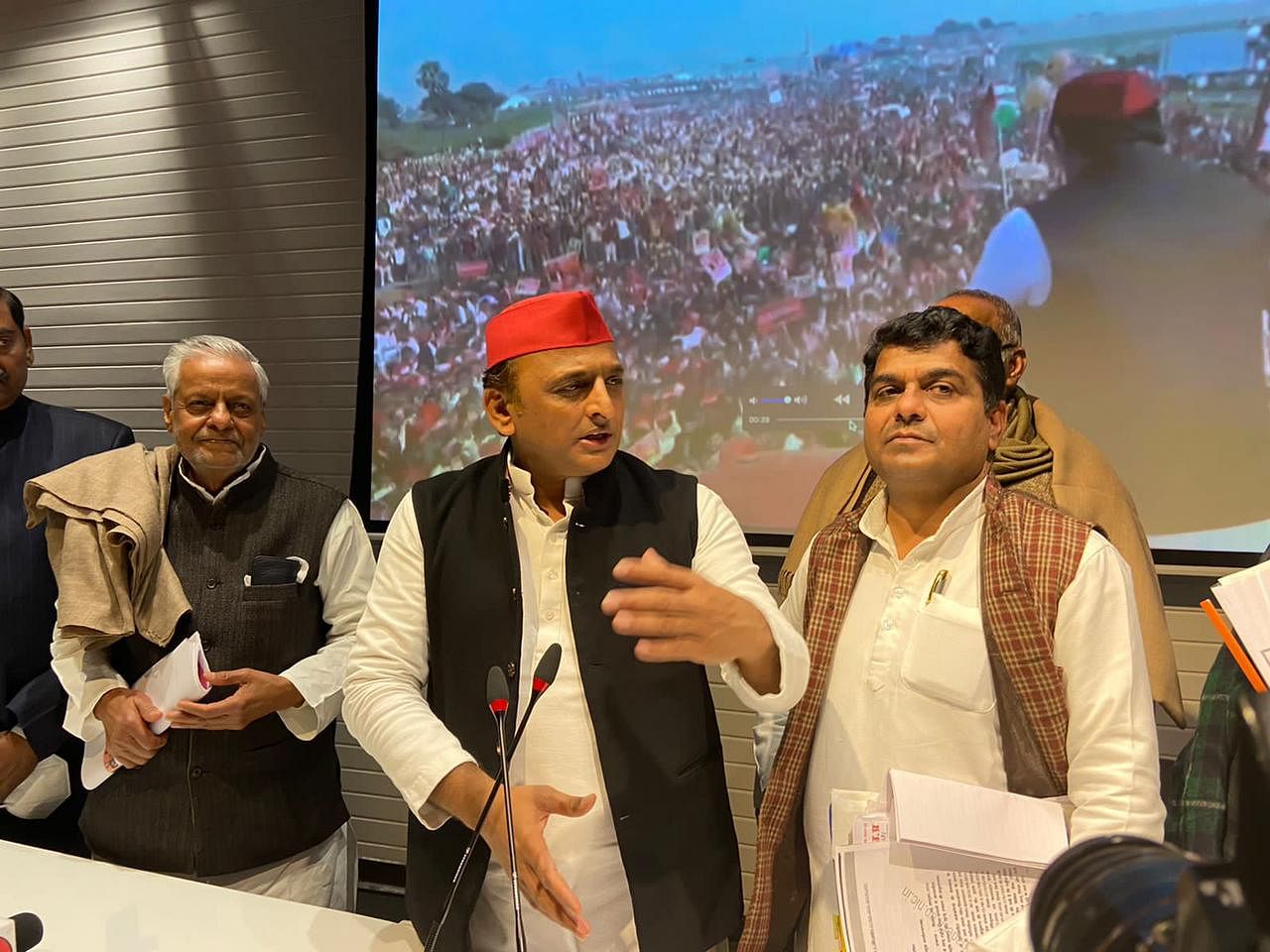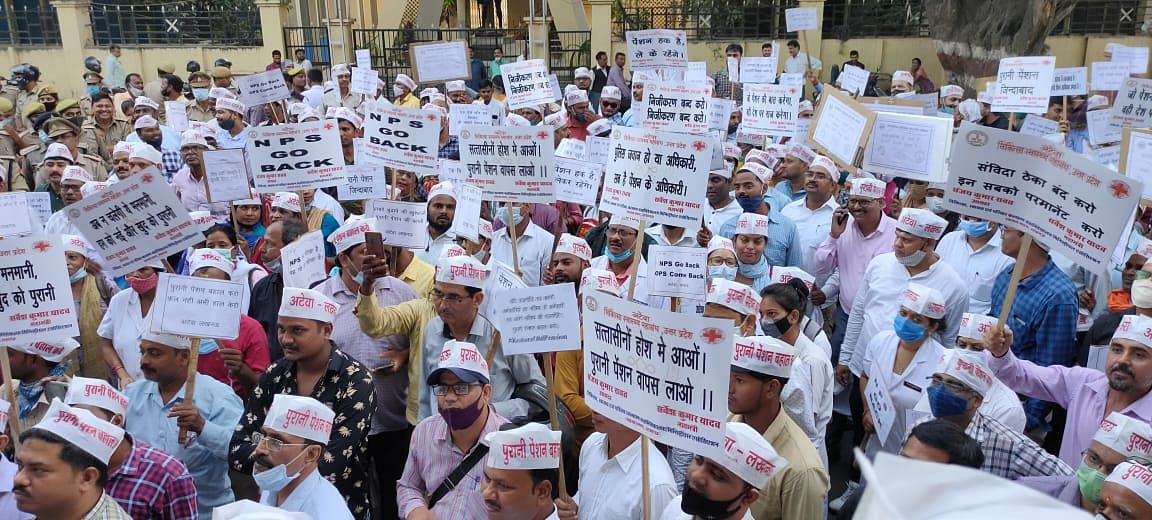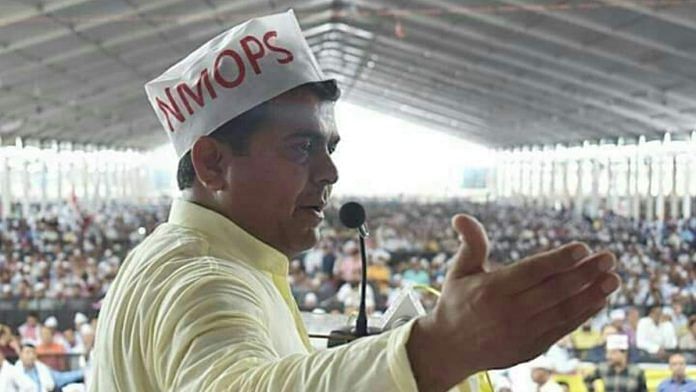New Delhi: Amongst the various poll promises covering all the party manifestos for the Uttar Pradesh assembly polls, the entry of one new item in the Samajwadi Party’s programme is testament to a longstanding demand.
It is the widespread call to reinstate the Old Pension Scheme (OPS) from government employees across the country — something that has grown steadily louder over the years in state after state — that has now been promised by the SP in its manifesto.
“Humein nayi urja mil gayi hai (We are feeling energised),” said Lucknow-based Vijay Kumar Bandhu, 44, a government lecturer at the JLNCD Rastogi Inter College, about SP mentioning OPS in its manifesto for the Uttar Pradesh assembly polls.
Bandhu has been the beating heart of the agitation to reinstate the OPS, and has nurtured the movement from its very inception in 2013, helping it to take concrete shape across several states.
The stamp of political approval by the SP sent ripples across other Indian states too.
In Himachal Pradesh, which will go to the polls later this year, the BJP government is facing a backlash from the Opposition as well as government employees over the issue of bringing back the OPS.
When the Congress staged a walk-out from the assembly this session and lakhs of government employees gheraoed it, the BJP government was forced to set up a committee to look into the matter.
In Jharkhand, Chief Minister Hemant Soren’s Jharkhand Mukti Morcha used the slogan “NPS (National Pension System) hai keval tension lauta do humari purani pension (NPS causes tension, give us back our old pension) during the 2019 assembly polls.
Now, he is being pressured by government employees’ associations to fulfil his promise, as they claim they overwhelmingly voted for him and that it was time to implement the scheme.
Similarly, in Andhra Pradesh, CM Y.S. Jaganmohan Reddy also announced the scrapping of the National Pension System in his manifesto before the 2019 assembly elections. He has announced a roadmap to revive the OPS by 31 March.
In Madhya Pradesh, government employees’ organisations have planned an agitation on 13 March in Bhopal.
Similar developments are being reported in Chhattisgarh, which will go to the polls next year.
There is one notable victory for those fighting for the OPS — on 23 February, Rajasthan’s Congress government led by Ashok Gehlot brought back the Old Pension Scheme in its budget session.
The Old Pension Scheme, which was replaced with the National Pension System (NPS) in January 2004 by the Centre for government employees recruited after 31 December, 2003, had various advantages for employees that are missing from the new version, say agitators.
The most prominent among them is a 10 per cent contribution from employees’ salaries towards the scheme, which wasn’t there in the OPS. Also, unlike in the OPS, there is no provision for provident fund in the NPS.
After 2004, most states had also scrapped the OPS in subsequent years.
But when Bandhu, along with a few others, started an organisation in 2013 whose declared goal was the ‘Restoration of Old Pension Scheme’, no one took them seriously.
Their small-scale protests did not attract national attention too.
As polling in the Uttar Pradesh polls winds up Monday, ThePrint looks at the key developments around the OPS issue, which has made it to the national headlines in just a fortnight.
Also read: Over 3L Rajasthan govt employees appointed after Jan 1, 2004 to be covered under old pension scheme
One man’s fight for OPS
Bandhu was an ordinary government employee until 2013.
A political science student at Allahabad University, he tried his luck for the state civil services exams, and was later selected by the Uttar Pradesh Secondary Education Service Selection Board.
He told ThePrint over a phone call how one conversation in 2013 changed his life.
“Upon telling an uncle that I joined service in mid-2004, he gave me a look of pity, and said that I would not get the secure old pension scheme benefits as I fell in the new pension scheme category,” he said.
“There was a lot of misinformation around the NPS. Everyone said ‘kai fayda hoga’, but would not pinpoint the exact benefits. I started collecting newspaper cuttings and educated myself on the whole issue,” Bandhu added.
And that’s when he realised, said Bandhu, that he had a fight on his hands.
After the conversation with his uncle, he founded an organisation called ATEWA (All Teachers Welfare Association) to fight for the Old Pension Scheme.
“Some of my colleagues joined in too, and that’s how we started this mission.”
ATEWA organised a small protest on 20 December 2015, which was attended by 700-800 people.
“Not bad for a start, for we thought it was a non-issue, and no one would notice us,” he told ThePrint.
Then, the association celebrated 1 April 2016 as a ‘black day’. On May 1, 2016, another rally attracted a crowd of 40,000 people.
Bandhu’s journey, to bring the issue of the OPS into the public domain, had started in earnest.
“As of now, around 70 lakh people are affected by this nationwide. In UP alone, there are 13 lakh people who are directly affected by it,” Bandhu said.
Then, of course, came the explosion in social media — a boon for all manners of protests.
“Our small-scale fight was magnified by the rise of social media too after 2013. It made it easy for us to organise nationally. We created a Facebook page, where more than 3 lakh government employees are connected. We created WhatsApp groups on state, district, and block level.”
First break, formation of NMOPS
The first big break for this movement came later, in 2018, when Bandhu and his group held a big rally in New Delhi’s Ram Leela Maidan.
Around four lakh people across many states attended the rally, which brought it to the attention of the national media.
As the demand for reinstating the OPS expanded in many states, a slogan was fashioned: “Jo humari pension ki baat karega wo raaj karega (Whoever talks about our pension, would rule).”
Bandhu claims that over the years, 13 FIRs have been filed against him for leading the pro-OPS agitation across the nation.
He has also helped in the formation of smaller organisations demanding the OPS in many states.
In 2017, seven state organisations (from UP, Punjab, Himachal Pradesh, Maharashtra, Karnataka, Telangana, and Andhra Pradesh) agitating for the OPS came together and registered as an umbrella organisation — the National Movement for Old Pension Scheme (NMOPS).
As of now, it operates in 22 states.
“With small-scale protests, rallies, signature campaigns, and padayatra meetings involving CMs and top BJP leaders…finally the efforts seem to be materialising in the five assembly elections in 2022,” Bandhu said.
Victory in Rajasthan, promise in UP
On 20 January 2022, SP chief Akhilesh Yadav held a press conference and promised to revive the OPS if elected to power.
Three days later, on 23 February, Rajasthan’s Congress government led by Ashok Gehlot rolled out the Old Pension Scheme in its budget session.
It is seen as Congress’ message to the voters of UP. In Himachal Pradesh too, it has been backing the demand by government employees to bring back the OPS.

While experts say the revival of the OPS would be a fiscal disaster, political parties see it otherwise — retired and serving government employees have emerged as a new vote bank.
Bandhu claimed that Hemant Soren’s support for the OPS won him a lot of postal ballot votes from government employees deployed in election duties.
“This is visible in UP too. Postal ballot votes are becoming important for the parties to win,” he added.
On 16 November 16, 2021, a large number of government employees held a protest in Dehradun.
On 13 February 2022, The New Pension Scheme Employees’ Federation started a padayatra from Mandi, Himachal Pradesh.
The federation claims that around two lakh government employees will become a decisive vote bank in the upcoming Himachal Pradesh assembly elections.
The demand was soon picked up by government employees in Madhya Pradesh. On 25 February, government employees announced a protest in Bhopal in mid-March.
MLAs across parties also wrote to CM Shivraj Singh Chouhan to revive the scheme.
Former CM Kamal Nath also asked the current CM to bring the OPS back.
OPS versus NPS
The Central government implemented the Old Pension Scheme under Central Civil Servcies (Pension) Act, 1972 to provide for its employees after retirement.
In it, there was no employees’ contribution, and after retirement the pensioner used to get 50 per cent of his/her last drawn salary. Moreover, in case of death, the spouse was given 25 per cent of the pension drawn. The OPS also had a GPF (General Provident Fund) facility.
But, in December 2003, the Atal Behari Vajpayee government did away with the Old Pension Scheme and introduced a new scheme — a contribution-based pensions scheme called the National Pension Scheme (NPS).
The NPS was mandatory for all new recruits under CGS (Central government service) from 1 January, 2004.
The government had amended Central Civil Services (Pension) Rules, 1972, Central Civil Service (Commutation of Pension) Rules, Central Civil Services (Extraordinary Pension) Rules, General Provident Fund Rules, and Contributory Provident Fund Rules to bring about the NPS.

In the new pension scheme, there is no provision for GPF, and employees have to contribute 10 per cent of their monthly salary towards the scheme.
Moreover, the pension amount is market linked, and invested in long-term mutual funds by the National Security Depository Limited ( NSDL). Thus, the volume of pension, in theory, will depend on the market value at the time of the withdrawal.
Bandhu and the various employees’ unions argue that the Old Pension Scheme worked as a safety net for government employees.
“The new pension scheme is market-linked. If there is an economic crash, it will have a direct effect on our pensions,” he said.
(Edited by Saikat Niyogi)
Also read: ‘Forced to beg, work at 72’: Why widows & elderly are protesting for pension in Telangana



